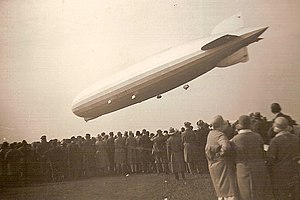LZ 127 Graf Zeppelin
| LZ 127 Graf Zeppelin | |
|---|---|
 |
|
| Role | Passenger/commercial airship |
| National origin | Germany |
| Manufacturer | Luftschiffbau Zeppelin |
| Designer | Ludwig Dürr |
| First flight | 18 September 1928 |
| Introduction | October 11, 1928 |
| Retired | 18 June 1937 |
| Status | Scrapped March 1940 |
| Primary user | DELAG
Deutsche Zeppelin-Reederei |
Deutsche Zeppelin-Reederei
LZ 127 Graf Zeppelin (Deutsches Luftschiff Zeppelin #127; Registration: D-LZ 127) was a German-built and -operated, passenger-carrying, hydrogen-filled, rigid airship which operated commercially from 1928 to 1937. When it entered commercial service in 1928, it became the first commercial passenger transatlantic flight service in the world. It was named after the German pioneer of airships, Ferdinand von Zeppelin, who was a count (Graf) in the German nobility. During its operating life, the airship made 590 flights covering more than 1.7 million kilometers (over 1 million miles). It was designed to be operated by a crew of 36 officers and men. The LZ 127 was the longest rigid airship at the time of its completion and was only surpassed by the USS Akron in 1931. It was scrapped for fighter plane parts in 1940.
Built at the Zeppelin Company works (Luftschiffbau Zeppelin) in Friedrichshafen am Bodensee (Lake Constance), Germany, between 1926 and 1928, the LZ-127 had a design patterned on that of the LZ-126, which the company had delivered as a war reparation to the U.S. Navy. The LZ-126 had been delivered at NAS Lakehurst, New Jersey, in October 1924, where it was commissioned as the USS Los Angeles (ZR-3). With that project completed, the Zeppelin company's chairman Dr. Hugo Eckener promptly began a two-year campaign of lobbying the German Government for funds and permission to proceed with construction of a new airship for Germany. Construction began in 1926 with the aid of a government grant although the majority of the necessary 2 million Reichsmarks (RM) in funding would eventually be raised by public subscription. The LZ 127 was completed and launched in September 1928.
...
Wikipedia
